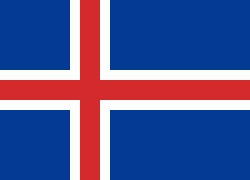Austurland
The largest town in the region is Egilsstaðir, with a population of 2,300. The oldest municipality is Djúpivogur, which got their trading licence in 1589 and had a population of 470 in 2015.
The only car and passenger ferry that sails between Iceland and the European continent calls at Seyðisfjörður once a week in the summer months and intermittently the rest of the year.
The region is home to the Kárahnjúkar Hydropower Plant. Among notable tourist destinations are the Helgustaðir mine, which is known for its Iceland spar, and Stuðlagil.
* List of populated places in Eastern Region (Iceland)
Map - Austurland
Map
Country - Iceland
 |
 |
| Flag of Iceland | |
According to the ancient manuscript Landnámabók, the settlement of Iceland began in 874 AD when the Norwegian chieftain Ingólfr Arnarson became the first permanent settler on the island. In the following centuries, Norwegians, and to a lesser extent other Scandinavians, immigrated to Iceland, bringing with them thralls (i.e., slaves or serfs) of Gaelic origin.
Currency / Language
| ISO | Currency | Symbol | Significant figures |
|---|---|---|---|
| ISK | Icelandic króna | kr | 0 |
| ISO | Language |
|---|---|
| DA | Danish language |
| EN | English language |
| DE | German language |
| IS | Icelandic language |
| NO | Norwegian language |
| SV | Swedish language |















